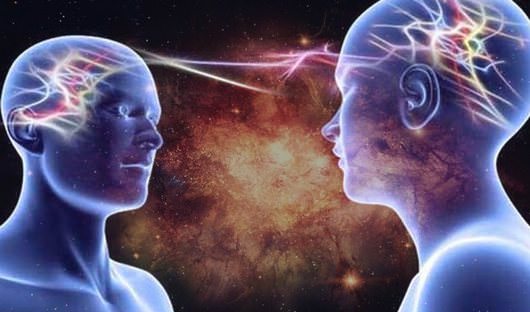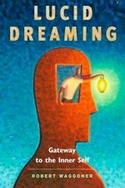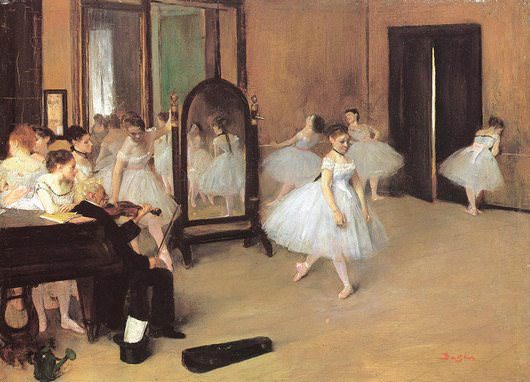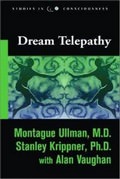What is The Evidence for Dream Telepathy?
Lucid dream telepathy is readily explored in the movie Inception. Multiple dreamers hook up to a shared dream environment, communicate as dream characters, and even plant a powerful idea into their target dreamer. Is there any basis for anything resembling mutual dreaming in reality?

What is The Evidence for Dream Telepathy?

A proponent of exploring the untapped potential of our hidden selves, Robert Waggoner dedicates a full chapter to the idea of dream telepathy in his book, Lucid Dreaming: Gateway to the Inner Self.
He points to the apparent phenomenon in psychiatric therapy sessions where patients are said to report "psychic glimpses" into the lives of their psychiatrists:
"Early in his career, psychiatrist and internationally renowned dream expert Dr Montague Ullman discovered something interesting while talking to his patients about their dreams. It seems that they occasionally dreamt about his life... One distrustful patient dreamt of giving a chromium soap dish to someone building a home. Unknown to his patient, Ullman had recently been looking at a chromium soap dish he had mistakenly received when building his house and had held onto 'in a spirit of belligerent dishonesty inspired by rising costs on the house...' The patient seemingly homed in on this small incident via dream telepathy as a poignant symbolic expression for his distrust of therapists."
~ Robert Waggoner Lucid Dreaming: Gateway to the Inner Self
Through the 1960s, Dr Ullman teamed up with the psychologist Stanley Krippner, PhD, and Alan Vaughan, to investigate dream telepathy scientifically at the Maimonides Medical Center sleep lab in Brooklyn.
They tested the hypothesis that they could make people could dream about randomly selected material such as artwork, movies and photographs through the telepathic medium alone.
A typical experiment involved a "telepathic sender" and a "telepathic receiver". They met in the lab first, then were sent to separate rooms.
The sender would open an envelope which contained the target image and then go to sleep. Meanwhile the receiver would sleep in another room and be awoken after a period of REM sleep to give a dream report.
After 10 years, Krippner and Ullman declared that their experiences yield statistically significant results... but did they?
The School of Dance
Here's an example of what was considered one significant and successful dream telepathy experiment. The sender's target was an art print called School of Dance by Edgar Degas:

School of Dance by Edgar Degas
The receiver reported the following dream:
"I was in a class made up of maybe half a dozen people, it felt like a school... There was one little girl that was trying to dance with me."
However, the glaring problem with this experiment is that the definition of a match is broad and subjectively interpreted. I personally would not have accepted that example as evidence of dream telepathy. Why?
If you asked me to describe the painting, I might say: "There are nine ballerinas in tutus warming up in front of mirrors. They appear to be young women. An old, smartly-dressed man sits with a violin, next to a piano. On the floor there is a top hat, a violin case, and a watering can. The scene is set in a dance school or studio."
If the telepathic receiver had described something more of that nature, I'd more readily accept it as a positive match. But it's important to note they missed the point that the ballerinas are actually women (check out their bosoms) not "little girls" and the most striking quality is that they are wearing tutus.
If You Want to Be a Bird
Here's another example from the Ullman and Krippner experiments, recorded in 1970. This one took place on a much larger scale; a local artist gave a projector show at a rock concert, thereby turning the whole audience into a group of telepathic senders.
First they watched a color film about eagles and their nesting habits, then all kinds of birds from around the world plus mythological birds like the phoenix. All the while, the Holy Modal Rounders played their song If You Want to Be a Bird.
Located in a 100-mile radius of the concert, the five telepathic receivers were told about the concert location and asked to record their dreams at midnight, around the time of the exposure. Here's what they reported:
The first receiver dreamed of "...something mythological, like a griffin or a phoenix."
The second reported "a snake", the third talked of "grapes" and the fourth dreamed of "an embryo in flames".
The fifth receiver did not sleep, however he did visualize "a number of seagulls flying over water".
Two out of five represents an excellent hit rate. Is this undeniable evidence of telepathic dreams?
Once again I think we should take an attitude of skepticism and ask the important questions.
Firstly, it's crucial to know if the dreamers reported other themes. It would be far less impressive, for example, if they also dreamed of (or visualized) lizards, tigers, flowers, boats, guns and ice trucking. Cherry picking dream data is a possible flaw in these experiments.
Even if they reported only birds as their major dream theme, I'd call into question the broad nature of the target material. It seems to me far too vague and general to transmit images of all different kinds of birds, both real and mythical. It's a scattershot approach.
You may be impressed that the first receiver dreamed of a phoenix, but this was one of many birds, making the chance odds of a successful match much higher. That's the problem with probabilities, though. Most people find them extremely difficult to comprehend rationally, and even the most skeptical individuals feel an instinctive need to attach meaning to events of pure coincidence.
To help overcome this chance effect, the target transmission should be specific and measurable. For instance, two blackbirds fighting over a wooden peg. Now we're getting specific. If a dreamer reported two blackbirds fighting over a wooden peg, it would be much harder to put down to coincidence and therefore much better evidence of dream telepathy. This kind of result, of course, would need to be readily repeatable to prove the existence of dream telepathy.
Other Dream Telepathy Experiments
 There are other examples we can draw from this 10-year study, detailed in the book Dream Telepathy: Experiments in Nocturnal ESP. However I do urge a skeptical mindset when considering the results.
There are other examples we can draw from this 10-year study, detailed in the book Dream Telepathy: Experiments in Nocturnal ESP. However I do urge a skeptical mindset when considering the results.
In the book, Ullman and Krippner muse on why the phenomenon first appeared in therapy sessions. They explain that the therapy couch is one of the few places in Western culture where dreams are widely discussed and taken seriously. They suggest that simple act of recording and remembering our dreams can bring awareness to such paranormal occurrences.
I'm definitely on board with the idea of taking our dreams seriously - or at least, understanding that they can be personally significant. I believe there is a solid place for dreamwork in psychological therapy and focusing on our dreams can bring all kinds of issues into focus.
Of course, lucid dreaming allows us the ability to actively seek out specific information in our dreams, while consciously aware in the moment. Whether that's intended in a therapeutic or a paranormal nature is up to you.
Peace, Moe, Peace
So far, dream telepathy experiments leave a lot to be desired. Lucid dreamers just might be able to change that.
Here's an example of suspected telepathy during a lucid dream. In Robert Waggoner's book he shares the story of Moe, in which a simple but unpredictable action in his lucid dream world became unconsciously implanted into her waking reality.
"I'm inside [a restaurant or bar] enjoying a feeling of lucid euphoria, when I see my friend Moe come inside... Trying to make some impact on her, I get the idea to make a peace sign with my fingers. I say, 'Look, Moe, do you see this peace sign? Every time you see it, it can make you become lucid - you'll know you're dreaming.' Again, I put the peace sign right in front of her face."
~ Robert Waggoner Lucid Dreaming: Gateway to the Inner Self
Four months later, Waggoner went traveling on business and met Moe for lunch. As he stood outside the restaurant, he was stunned to see her approach with a curious look in her eye... then she suddenly reach up and put a peace sign in front of his face.
"Why did you do that?" he asked. Moe just shrugged and said nonchalantly, "I don't know. Just felt like it."
Did he telepathically tell Moe to do the peace sign in front of his face? Was it an impulse implanted telepathically during his lucid dream?
Final Thoughts
"Life imitates art far more than art imitates life."
~ Oscar Wilde
The dream telepathy featured in Inception was facilitated by technology; specifically a shared dream device called PASIV. And I think that's where we're headed in the distant future if we're ever to see the possibility of group dreaming or anything that resembles telepathy.
Of course, rationalism does not currently explain everything about the world around us. If it floats your boat, I encourage you to perform your own lucid dream experiments. So often, our inner world seems the least explored one, and with lucid dreaming we have a revolutionary psychological tool to investigate this inner reality.
















